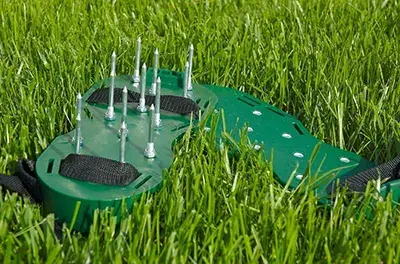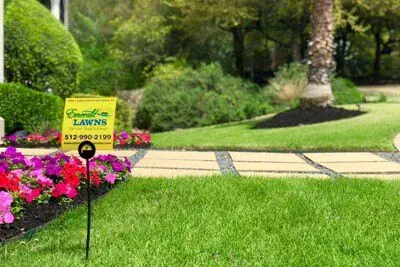Trees and shrubs need nutrients to stay healthy, but Texas soil and weather conditions often make it hard for them to get what they need naturally. Tree fertilization helps fill that gap by strengthening roots and boosting growth. It also helps improve resistance to pests, drought, and disease. The timing of fertilization also matters, especially in areas like Austin, DFW, Houston, and San Antonio.
Emerald Lawns offers professional tree and shrub fertilization services designed for Texas yards. In this guide, we’ll explain the benefits of tree and shrub fertilization, the best time to fertilize trees and shrubs, and how to support plant health across different regions of the state.
What Is Tree Fertilization?
Tree fertilization is the process of adding nutrients to the soil to help trees and shrubs grow strong and stay healthy. Over time, soil in Texas landscapes can lose nutrients due to heat, rainfall, poor soil structure, or simply the demands of growing plants. Fertilizing supports the entire tree, from the roots underground to the leaves at the top. It helps trees recover from stress, grow fuller canopies, and resist problems common in our Texas climate.
The main nutrients trees need are nitrogen, phosphorus, and potassium. Nitrogen supports leaf and canopy growth. Phosphorus helps with root development and flower production. Potassium strengthens the tree’s ability to fight off stress from drought, pests, and disease. Trees also need smaller amounts of micronutrients like iron, zinc, and manganese.
Benefits of Tree and Shrub Fertilization
Given Texas's soil and climate conditions, fertilizing your trees and shrubs helps them grow stronger and stay healthier. Here’s what the right nutrients can do for your landscape:
- Healthier, Greener Foliage: Nutrients support full canopy growth and rich leaf color.
- Stronger Root Systems: Deep, well-fed roots help trees stay stable and absorb water efficiently.
- Better Resistance to Stress: Fertilized trees handle drought, heat, pests, and disease more effectively.
- Improved Flowering and Fruiting: Trees and shrubs are more likely to bloom on time and produce healthy fruit.
- Longer Life Span: Proper nutrition helps trees recover from stress and live longer.
- Boosted Curb Appeal: Vibrant, healthy trees and shrubs make your entire yard look better.
Consistent fertilization strengthens trees and shrubs over time and transforms the entire landscape into a healthier, more resilient outdoor space.
Best Time To Fertilize Trees and Shrubs in Texas
The best time to fertilize trees and shrubs in Texas is early spring and fall. These windows give plants the nutrients they need right before periods of active growth or recovery.
|
Season |
When |
Purpose |
Benefits |
|
Spring |
February to April |
Prepares plants for the growing season. |
Supports new leaf growth, flowering, and roots. |
Fall |
October to November |
Replenishes nutrients and prepares for dormancy. |
Strengthens roots, improves cold/drought defense. |
Avoid fertilizing in the peak of summer. High heat and dry soil can limit absorption and stress your trees.
Regional Considerations
- Houston: This area generally has a longer growing season. Consider a second, lighter application in late summer.
- DFW and Austin: Many places here have clay-heavy and rocky soils that often need deep root feeding for better results.
- San Antonio: Homeowners and property managers should fertilize when the soil is moist to reduce stress from dry conditions.
When To Fertilize Trees and Shrubs (By Plant Type)
The right fertilization schedule depends on the age and type of plant. Young trees and newly planted shrubs need frequent feeding to establish strong roots. You can fertilize them two to three times yearly, ideally in early spring, midsummer (if needed), and fall. Tailoring your fertilization routine to your plant’s needs helps ensure long-term health and stronger results across your landscape.
Mature trees usually only need fertilization once a year unless they show signs of stress, like thinning foliage or poor growth. For these, spring or fall are still the best times.
Plant type also matters:
- Evergreens: Fertilize these in early spring to support steady year-round growth.
- Deciduous Trees and Shrubs: Fertilize these types in spring and again in fall to match their active and dormant cycles.
How To Tell If Your Trees Need Fertilization
Not all trees and shrubs need fertilizer every year. The best way to know is to watch for signs that your plants aren’t getting the necessary nutrients.
Here are some of the symptoms to be aware of:
- Yellowing leaves or pale foliage, especially in the growing season
- Slow or stunted growth, even with proper watering
- Thin canopies or branch dieback
- Poor flowering or fruit production in species that normally bloom or bear fruit
Sometimes, these issues are caused by poor soil or nutrient deficiencies that aren’t obvious at first glance. A professional soil test can reveal what’s missing and help guide the right treatment. If your trees show any of these signs, it may be time to consider tree fertilization to restore their health and growth.
Types of Tree Fertilization Methods
There are several ways to fertilize trees and shrubs, and the best method often depends on your soil, plant type, and landscape goals.
Surface Application
Granular fertilizer is spread around the base of the tree and watered in. This is simple but may not reach deeper roots, especially in compacted or clay-heavy soils.
Deep Root Feeding
Nutrients are injected directly into the soil, targeting the root zone. This method is highly effective in Texas soils and helps trees absorb nutrients quickly and evenly.
Slow-Release vs. Quick-Release Fertilizers
Slow-release fertilizers feed trees over time, which reduces the risk of over-fertilizing. On the other hand, quick-release variants work faster but may need more frequent applications and can stress plants if not applied correctly.
If you’re unsure how much and which type of fertilizer to use, it is best to consult with lawn care experts. Professional services ensure the right method, dosage, and timing so nutrients go exactly where needed.
Why DIY Isn’t Always Enough
Spreading store-bought fertilizer may seem simple, but overdoing it or choosing the wrong product is easy. Too much fertilizer can burn roots, while a poor match for your soil won’t deliver the desired results. Professional tree care ensures accurate timing, proper dosage, and products suited to your local conditions. It’s a safer, more effective way to help your trees grow strong and stay healthy.
Why Homeowners in Texas Trust Emerald Lawns
At Emerald Lawns, we understand that tree fertilization is essential to the long-term health and beauty of your landscape. We tailor our solutions to the unique soil, weather, and plant needs across Austin, DFW, Houston, and San Antonio, giving your trees and shrubs exactly what they need and when needed.
Contact Emerald Lawns to schedule expert tree and shrub fertilization tailored to your Texas yard.


.png?width=1142&height=1350&name=Holiday%20Decor%202025%20LP%20-%20548x648%20%20(1).png)


